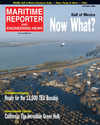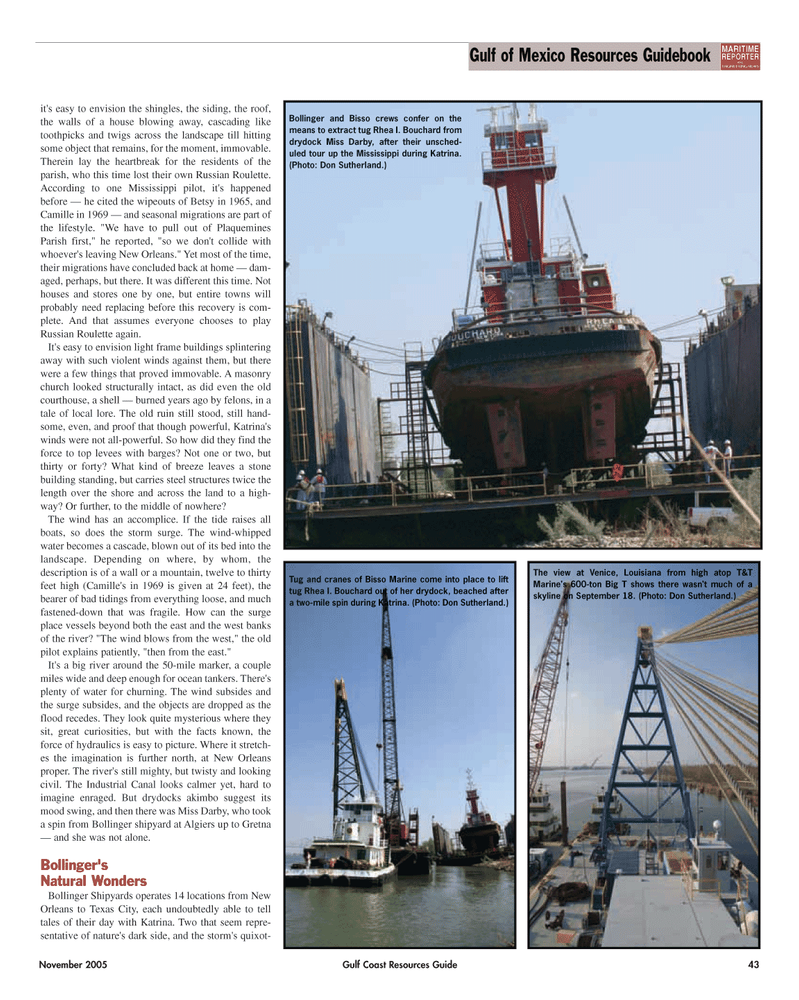
Page 43: of Maritime Reporter Magazine (November 2005)
The Workboat Annual Edition
Read this page in Pdf, Flash or Html5 edition of November 2005 Maritime Reporter Magazine
it's easy to envision the shingles, the siding, the roof, the walls of a house blowing away, cascading like toothpicks and twigs across the landscape till hitting some object that remains, for the moment, immovable.
Therein lay the heartbreak for the residents of the parish, who this time lost their own Russian Roulette.
According to one Mississippi pilot, it's happened before — he cited the wipeouts of Betsy in 1965, and
Camille in 1969 — and seasonal migrations are part of the lifestyle. "We have to pull out of Plaquemines
Parish first," he reported, "so we don't collide with whoever's leaving New Orleans." Yet most of the time, their migrations have concluded back at home — dam- aged, perhaps, but there. It was different this time. Not houses and stores one by one, but entire towns will probably need replacing before this recovery is com- plete. And that assumes everyone chooses to play
Russian Roulette again.
It's easy to envision light frame buildings splintering away with such violent winds against them, but there were a few things that proved immovable. A masonry church looked structurally intact, as did even the old courthouse, a shell — burned years ago by felons, in a tale of local lore. The old ruin still stood, still hand- some, even, and proof that though powerful, Katrina's winds were not all-powerful. So how did they find the force to top levees with barges? Not one or two, but thirty or forty? What kind of breeze leaves a stone building standing, but carries steel structures twice the length over the shore and across the land to a high- way? Or further, to the middle of nowhere?
The wind has an accomplice. If the tide raises all boats, so does the storm surge. The wind-whipped water becomes a cascade, blown out of its bed into the landscape. Depending on where, by whom, the description is of a wall or a mountain, twelve to thirty feet high (Camille's in 1969 is given at 24 feet), the bearer of bad tidings from everything loose, and much fastened-down that was fragile. How can the surge place vessels beyond both the east and the west banks of the river? "The wind blows from the west," the old pilot explains patiently, "then from the east."
It's a big river around the 50-mile marker, a couple miles wide and deep enough for ocean tankers. There's plenty of water for churning. The wind subsides and the surge subsides, and the objects are dropped as the flood recedes. They look quite mysterious where they sit, great curiosities, but with the facts known, the force of hydraulics is easy to picture. Where it stretch- es the imagination is further north, at New Orleans proper. The river's still mighty, but twisty and looking civil. The Industrial Canal looks calmer yet, hard to imagine enraged. But drydocks akimbo suggest its mood swing, and then there was Miss Darby, who took a spin from Bollinger shipyard at Algiers up to Gretna — and she was not alone.
Bollinger's
Natural Wonders
Bollinger Shipyards operates 14 locations from New
Orleans to Texas City, each undoubtedly able to tell tales of their day with Katrina. Two that seem repre- sentative of nature's dark side, and the storm's quixot-
Gulf of Mexico Resources Guidebook
MARITIME
REPORTER
AND
ENGINEERINGNEWS
November 2005 Gulf Coast Resources Guide 43
Bollinger and Bisso crews confer on the means to extract tug Rhea I. Bouchard from drydock Miss Darby, after their unsched- uled tour up the Mississippi during Katrina. (Photo: Don Sutherland.)
Tug and cranes of Bisso Marine come into place to lift tug Rhea I. Bouchard out of her drydock, beached after a two-mile spin during Katrina. (Photo: Don Sutherland.)
The view at Venice, Louisiana from high atop T&T
Marine's 600-ton Big T shows there wasn't much of a skyline on September 18. (Photo: Don Sutherland.)
MR NOVEMBER 2005 #6 (41-48).qxd 10/28/2005 10:07 AM Page 43

 42
42

 44
44
